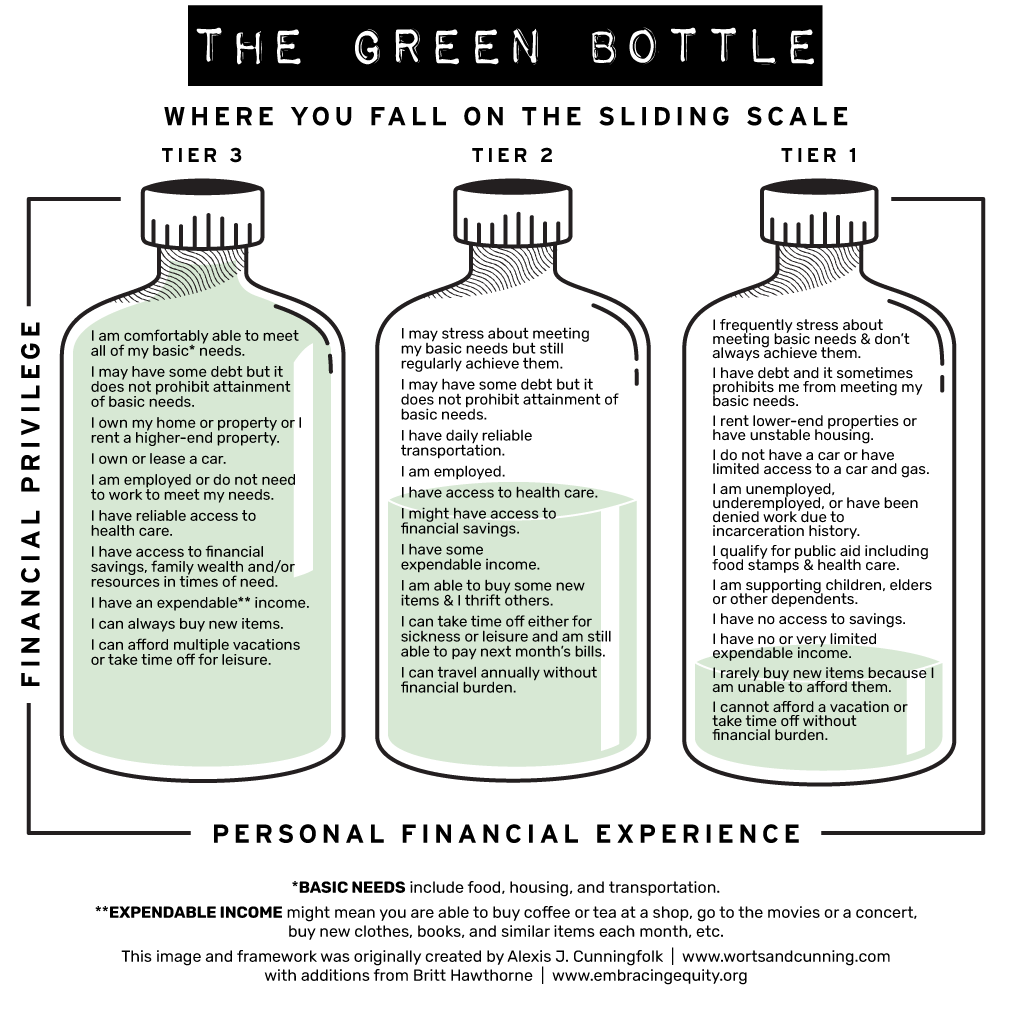What is a sliding scale?
A capitalist system determines our financial access and value by race, perceived gender identity, disability/ability, immigration status, and/or primary language among many other systems of imposed hierarchy. There is no exact formula that determines what each of us can afford, because income is not the only determining factor. For example, your relationship to money might also be affected by being a caregiver, your access to generational wealth, and/or costs related to a disability.
A sliding scale is used to encourage people to pay according to their available resources. Those with greater financial privilege contribute more, allowing those with less access, to pay according to their means. This allows the business to sustain its services while making accessibility as broad as possible.
How do I choose what to pay?
The Green Bottle chart below expands our understanding of financial privilege and experience. Please use it to determine the level you’re able to invest. See below for image description.

This image and framework was originally created by Alexis J. Cunningfolk | www.wortsandcunning.com with additions from Britt Hawthorne | www.embracingequity.org
Why might I feel uncomfortable about this?
Capitalism persists because of its ability to transmit shame, and therefore halt the uncomfortable tasks required to upend it.
If you need to invest less in Radical History Club, please do so. In the words of Britt Hawthorne, poverty is a condition that governments and employers insist on maintaining. You are not poor because you did not work hard. You are not poor because you are not intelligent. You are not poor because you chose to be.
If you can invest more in Radical History Club, please do so. Your decision to invest more is an act of solidarity and a refusal to accept the benefits of racial capitalism and privilege. Your investment will go towards subsidizing level 1 purchases, paying contributors and sponsoring classroom donations.
Image description: Graphic with the title, “The Green Bottle: Where You Fall on the Sliding Scale.” Three illustrations of bottles appear side by side, one filled all the way with green liquid, the second filled halfway, and the third filled low. Each bottle has a list of statements. Along the y-axis of the graphic reads, “Financial Privilege” and the x-axis reads, “Personal Financial Experience.” The full bottle lists the following statements: “I am comfortably able to meet all of my basic* needs. I may have some debt but it does not prohibit attainment of basic needs. I own my home or property OR I rent a higher-end property. I own or lease a car. I am employed or do not need to work to meet my needs. I have regular access to health care. I have access to financial savings. I have an expendable** income. I can always buy new items. I can afford an annual vacation or take time off.” The half-filled bottle lists the following statements: “I may stress about meeting my basic needs but still regularly achieve them. I may have some debt but it does not prohibit attainment of basic needs. I own or lease a car. I am employed. I have access to health care. I might have access to financial savings. I have some expendable income. I am able to buy some new items & I thrift others. I can take a vacation annually or every few years without financial burden.” The low-filled bottle lists the following statements: “I frequently stress about meeting basic needs & don’t always achieve them. I have debt and it sometimes prohibits me from meeting my basic needs. I rent lower-end properties or have unstable housing. I do not have a car and/or have limited access to a car but I am not always able to afford gas. I am unemployed or underemployed. I qualify for government assistance including food stamps & health care. I have no access to savings. I have no or very limited expendable income. I rarely buy new items because I am unable to afford them. I cannot afford a vacation or have the ability to take time off without financial burden.” At the very bottom of the graphic are additional definitions. “*Basic Needs include food, housing, and transportation. **Expendable Income might mean you are able to buy coffee or tea at a shop, go to the movies or a concert, buy new clothes, books, and similar items each month, etc. This image and framework was originally created by Alexis J. Cunningfolk | www.wortsandcunning.com with additions from Britt Hawthorne | www.embracingequity.org.”
